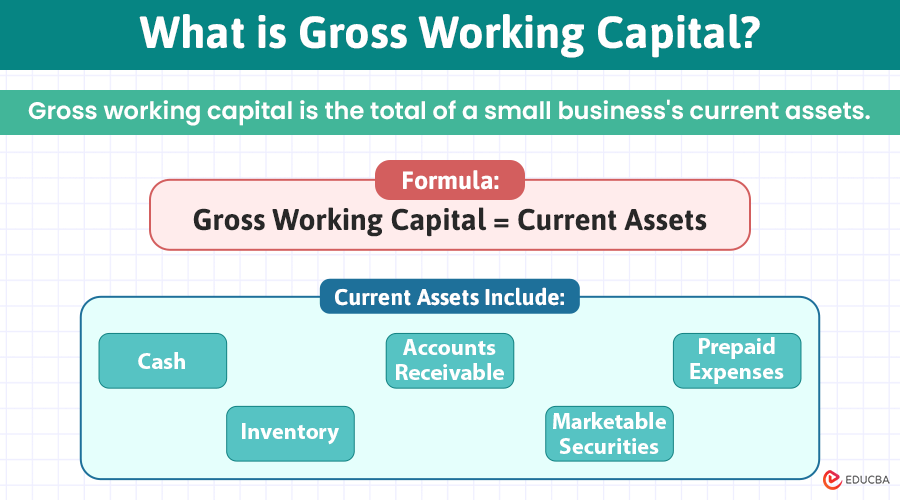Introduction to the Gross Working Capital Formula
Running a small business is challenging, as it involves handling daily operations, vendor follow-ups, market research, and more. One of the most important aspects to manage is finances, and understanding gross working capital is crucial for every MSME owner in India. The gross working capital formula helps business owners ensure smooth operations, meet short-term obligations, and manage the flow of funds effectively.
What is Gross Working Capital?
Gross working capital is the total of a small business’s current assets. The business uses short-term, liquid assets to meet its obligations and manage daily operations.
Examples of current assets include:
- Cash
- Inventory
- Accounts Receivable
- Marketable Securities
- Prepaid Expenses
These assets are typically liquid; the business expects to convert them into cash or use them within a year.
What is the Gross Working Capital Formula?
Below is the Gross Working Capital formula:
Gross Working Capital = Current Assets
Gross Working Capital = Cash + Accounts Receivable + Inventory + Marketable Securities + Prepaid Expenses
Now that you understand the Gross Working Capital formula, it will be easy for you to determine if your MSME needs a working capital loan to support your business.
Now, let us understand the individual elements:
- Cash: This refers to the money your business has on hand or in the bank, available for immediate use to cover expenses.
- Accounts Receivable: This is the money customers owe your business for goods or services bought on credit.
- Inventory: This includes the products or raw materials your business has on hand, ready to be sold or used in production.
- Marketable Securities: These short-term investments, such as government bonds or mutual funds, can be easily converted into cash.
- Prepaid Expenses: Your business pays for expenses in advance, such as insurance or rent, which it will use in the future.
Differences Between Gross and Net Working Capital
Here are the key differences between Gross and Net Working Capital:
| Aspect | Gross Working Capital | Net Working Capital |
| Definition | The total of all current assets a business owns. | It is the gap between a company’s current assets and current liabilities. |
| Purpose | Measures the total short-term resources available for operations. | Evaluates the business’s ability to meet short-term financial obligations. |
| Components | Includes accounts receivable, cash, other current assets, and inventory. | Concentrates on the gap between current assets and current liabilities. |
| Key Use | To assess the total amount of liquid assets a business can use within a year. | To understand if the business has enough liquidity to manage short-term debts. |
| Financial Health Indicator | Indicates the total resources for daily operations. | Shows whether a business can meet its current obligations. |
Net Working Capital Formula is as follows:
For example, a company has current assets at ₹100,000 and current liabilities at ₹60,000.
Let us calculate Net Working Capital and Gross Working Capital:
Net Working Capital
Net Working Capital = Current Assets – Current Liabilities
Net Working Capital = ₹100,000 – ₹60,000
Net Working Capital = ₹40,000
This means that after covering its short-term debts, the company will be left with ₹40,000 to manage other operational needs.
Gross Working Capital
Gross Working Capital refers only to the total of current assets, which in this case is ₹100,000. It does not consider the company’s liabilities.
Gross Working Capital = ₹100,000 (Current Assets)
While Gross Working Capital shows how much liquidity a business has, Net Working Capital clarifies the company’s financial health by factoring in its short-term obligations.
Why Is Gross Working Capital Important to Entrepreneurs?
Here are a few reasons why understanding Gross Working Capital would be essential:
1. Manages Liquidity
Entrepreneurs need to know their liquid capital at any given time to make important decisions. Gross Working Capital shows how much money the business can access immediately to pay expenses, purchase inventory, or pursue new opportunities.
2. Ensures Smooth Operations
With enough Gross Working Capital, a business can meet its daily financial obligations without issues. Even profitable businesses can face problems if they lack sufficient working capital to pay bills and maintain smooth operations.
3. Improves Decision Making
Knowing the available working capital helps entrepreneurs decide when to invest or raise more capital for growth. It also shows whether the business should seek additional resources to expand or borrow more funds.
4. Attracts Investors
Investors are interested in a company’s working capital. A healthy level of Gross Working Capital shows that the business can pay its short-term debts, making it more appealing to potential investors.
5. Plans for the Future
Gross Working Capital helps entrepreneurs plan. If current assets are insufficient to cover future expenses, they can make arrangements in advance, avoiding unexpected costs.
Final Thoughts
Gross Working Capital is an important concept for entrepreneurs. It represents the liquid assets available to run a business efficiently. It ensures enough cash to run daily operations, pay bills, and seize growth opportunities. While Gross Working Capital does not consider liabilities like Net Working Capital, it is still crucial for managing the business’s financial health on a day-to-day basis.
For small business owners looking to grow, applying for a small business loan from an NBFC (Non-Banking Financial Company) is a good option. NBFCs offer quicker loan approvals, flexible terms, and fewer documentation requirements than traditional banks. This makes it easier for small businesses to secure the funds they need to improve working capital, expand, or support business growth.
Recommended Articles
We hope this guide helps you understand the Gross Working Capital formula and its importance for your business. Check out these recommended articles for more insights on financial management and business growth strategies.



